2017 in Review and Top 20 + 5 Shakespeareances
Theater As Craft and Context
This is what theater can do:
- In the wake of seeing Donmar Warehouse's production of The Tempest at St. Ann's Warehouse in Brooklyn, New York, I studied up on Hannah, the real-life prisoner that actress Harriet Walter portrayed playing Prospero, and learned about women in prison as a social issue and not just as a setting for sexploitation films.
- A production of The Merchant of Venice at the American Shakespeare Center's Blackfriars Playhouse in Staunton, Virginia, that induced a year's worth of uncontrolled laughter also had me reflecting on my ongoing issues with depression and my own Christian background in the context of social prejudice and racial disenfranchisement.
- A famous comic scene in Henry VI, Part 2, as played in Taffety Punk's Bootleg Shakespeare production at the Folger Theatre in Washington, D.C., forecasted a real-life tragic scene not far away just a few weeks later, our uncomfortable laughter watching the play altered to discomforting alarm watching the newscasts.
- Shakespeare Opera Company's blending of William Shakespeare's A Midsummer Night's Dream with Felix Mendelssohn's incidental music for the play introduced Shakespeare lovers to classical music, and vice versa.
- I cried. It was at another production of A Midsummer Night's Dream, one that opened Cincinnati Shakespeare Company's lovely new theater. I was laughing so hard the tears soaked my beard.
- I saw dancing mermaids.
I don't know of anyone among my family, loved ones, close friends, and associates from a spectrum of cultural backgrounds and ideological positions who felt 2017 was a good year. A general doldrums enveloped society, a pervasive depression settled on me. The Shakespeare play that dominated the year, Julius Caesar, did so because the political turmoil that has displaced true governance and the dissentious nature the population on both sides of the political divide have chosen to embrace overtook the artistic intent of one production. We did not see that Public Theater Shakespeare in the Park staging of Julius Caesar, casting Donald Trump as Caesar and creating a firestorm that engulfed other productions of the play across the country. We did see two other productions of that play during which we couldn't help seeing current politicians in various roles. But we could say that about a number of Shakespeare plays we saw this year: Richard III, Measure for Measure, Coriolanus, The Merchant of Venice, Macbeth, Henry VI, Part Two and Part Three, King John, King Lear, Romeo and Juliet, The Tempest, and even As You Like It.
That is what theater is meant to do: Make you reflect, inspire you to learn (a quality I regret to say is missing in political discourse these days, even among our elected leaders in both parties), and then take action, even if just to better your own disposition. Theater is also meant to entertain, to move you to tears when Mercutio dies (and you are genuinely sad at the loss) or when Pyramus dies (and you laugh yourself to a wet beard).
Although we saw fewer plays in 2017 than we have in previous years, we visited more theater companies for the first time than ever before. I can say with absolute confidence that theater is thriving across America, perhaps not commercially or financially but certainly in terms of talent and craftsmanship. Indeed, if you want to see great Shakespeare, you don't have to head to the great metropolises of this land or the long-established centers of Bardolatry. You can merely turn your car around and head into the rural centers across this land and the many parks and community centers where Shakespeare productions pop up then move along. Our own intent to do so in 2017 laid the foundation for a more concerted effort in this regard for 2018 (an effort to be formally announced in the next couple of days).
And it was on such a journey that we encountered my favorite Shakespeareance of 2017. Competition for that spot was fierce, given the tears, the laughter, the heavyweight performances, and the subject-matter resonance of what we experienced this year. Any one of the top five could have been number one in other years. However, after such a year and with much reflection, my recollections kept returning to a production featuring incredible theatrical craftsmanship built upon a studied understanding of Shakespeare's text that left me smiling big, even to the very moment that I'm typing this, readying to pull the curtain on my Top 20 Shakespeareances of 2017.
And to be able to smile at the end of this year is what theater can do.
Top 20 Shakespeareances of 2017
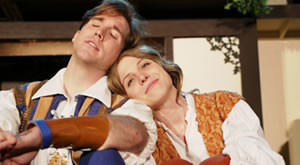 As You Like It, Ohio Shakespeare Festival, Akron, Ohio, July 9. Settled in to a lovely outdoor theater, I awaited some pleasant provincial theater. Thirty minutes later, I was in wide-eyed awe—and the play hadn't even begun; this was just the Greenshow. Then, Ryan Zarecki came on as Orlando, and five lines into his opening speech, the audience was laughing at Shakespeare's humor—yes, in Orlando's opening expository speech—and I knew we were in for an incredible performance. Many performances, as it turned out, not only from Zarecki but also from Tess Burgler's Rosalind, so hopelessly in love it logically drove the plot, and from Geoff Knox's Jaques who was funny. Really! Director Terry Burgler had two priorities in staging Shakespeare's pastoral rom-com: to make it romantic, and to make it comical, and in the wooded pastoral setting of this theater, this was as close to a perfect staging of As You Like It as I'm ever likely to see.
As You Like It, Ohio Shakespeare Festival, Akron, Ohio, July 9. Settled in to a lovely outdoor theater, I awaited some pleasant provincial theater. Thirty minutes later, I was in wide-eyed awe—and the play hadn't even begun; this was just the Greenshow. Then, Ryan Zarecki came on as Orlando, and five lines into his opening speech, the audience was laughing at Shakespeare's humor—yes, in Orlando's opening expository speech—and I knew we were in for an incredible performance. Many performances, as it turned out, not only from Zarecki but also from Tess Burgler's Rosalind, so hopelessly in love it logically drove the plot, and from Geoff Knox's Jaques who was funny. Really! Director Terry Burgler had two priorities in staging Shakespeare's pastoral rom-com: to make it romantic, and to make it comical, and in the wooded pastoral setting of this theater, this was as close to a perfect staging of As You Like It as I'm ever likely to see.
 The Tempest, Donmar Warehouse, St. Ann's Warehouse, Brooklyn, New York, January 28. Hers may not be the preeminent Prospero I've seen, but Harriet Walter as prison inmate Hanna playing Prospero was extraordinary in its character duality, emotional depth, and technical expertise. This was the final installment of Phyllida Lloyd's Shakespeare Trilogy, all set in a women's prison, and what began as a metaphor for Rome in Julius Caesar and continued as an allegorical setting for Henry IV concluded with The Tempest as the medium for a story about Hanna's drama group and the redemptive powers of Shakespeare. A crowning achievement.
The Tempest, Donmar Warehouse, St. Ann's Warehouse, Brooklyn, New York, January 28. Hers may not be the preeminent Prospero I've seen, but Harriet Walter as prison inmate Hanna playing Prospero was extraordinary in its character duality, emotional depth, and technical expertise. This was the final installment of Phyllida Lloyd's Shakespeare Trilogy, all set in a women's prison, and what began as a metaphor for Rome in Julius Caesar and continued as an allegorical setting for Henry IV concluded with The Tempest as the medium for a story about Hanna's drama group and the redemptive powers of Shakespeare. A crowning achievement.
 A Midsummer Night's Dream, Cincinnati Shakespeare Company, Cincinnati, Ohio, September 9. I seldom laugh so hard that tears flow down my checks to my beard. We were here for the opening of the Otto M. Budig Theater, which in itself earns an A grade, but it was the play, intended as both a celebration and a means of showing off all that the new theater has to offer, that left us wowed. The company's producing artistic director, Brian Isaac Phillips, helmed a production that blended extratextual matter with purely literal readings of the lines to create comic magic. He worked in metatheater elements befitting the new space, and made great use of a talented ensemble, including the most inventive Helena (Caitlin McWethy) I've seen and the absolute longest Pyramus death scene ever.
A Midsummer Night's Dream, Cincinnati Shakespeare Company, Cincinnati, Ohio, September 9. I seldom laugh so hard that tears flow down my checks to my beard. We were here for the opening of the Otto M. Budig Theater, which in itself earns an A grade, but it was the play, intended as both a celebration and a means of showing off all that the new theater has to offer, that left us wowed. The company's producing artistic director, Brian Isaac Phillips, helmed a production that blended extratextual matter with purely literal readings of the lines to create comic magic. He worked in metatheater elements befitting the new space, and made great use of a talented ensemble, including the most inventive Helena (Caitlin McWethy) I've seen and the absolute longest Pyramus death scene ever.
 Benjamin Reed as Arragon in The Merchant of Venice, American Shakespeare Center, Blackfriars Playhouse, Staunton, Virginia, January 21. John Harrell gave an incisive study on Shylock as a victim and product of racism. David Anthony Lewis revealed the Christian foundation for Antonio and how that impacts his behavior in the trial (what we call bigotry is, for him, love). Jessika Williams gave Shakespeare hip-hop cred as the Prince of Morocco. But really, in an original practice production that lacked overall cohesion, this ranking settles on the nerd-infused line readings of Benjamin Reed's Prince of Arragon, with light saber, wizard hat, and invisibility cloak, that has left me in awe and still laughing these past 12 months.
Benjamin Reed as Arragon in The Merchant of Venice, American Shakespeare Center, Blackfriars Playhouse, Staunton, Virginia, January 21. John Harrell gave an incisive study on Shylock as a victim and product of racism. David Anthony Lewis revealed the Christian foundation for Antonio and how that impacts his behavior in the trial (what we call bigotry is, for him, love). Jessika Williams gave Shakespeare hip-hop cred as the Prince of Morocco. But really, in an original practice production that lacked overall cohesion, this ranking settles on the nerd-infused line readings of Benjamin Reed's Prince of Arragon, with light saber, wizard hat, and invisibility cloak, that has left me in awe and still laughing these past 12 months.
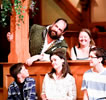 Much Ado About Nothing, American Shakespeare Center, Staunton, Virginia, September 24. Director Jenny Bennett not only embraces the staging conditions of the Blackfrairs Playhouse, she grasps Shakespeare's understanding of his own play space re-created by the American Shakespeare Center's Blackfriars. Ironically, this purity made for an intelligently innovative staging of this oft-produced play highlighted by the freshest takes on Beatrice (Allison Glenzer) and Benedick (David Anthony Lewis) I have ever seen. Dramatic at times but a comedy always, this was both a fun and deeply moving production.
Much Ado About Nothing, American Shakespeare Center, Staunton, Virginia, September 24. Director Jenny Bennett not only embraces the staging conditions of the Blackfrairs Playhouse, she grasps Shakespeare's understanding of his own play space re-created by the American Shakespeare Center's Blackfriars. Ironically, this purity made for an intelligently innovative staging of this oft-produced play highlighted by the freshest takes on Beatrice (Allison Glenzer) and Benedick (David Anthony Lewis) I have ever seen. Dramatic at times but a comedy always, this was both a fun and deeply moving production.
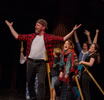 Henry VI, Part 2, Taffety Punk Bootleg Shakespeare, Folger Theatre, Washington, D.C., July 23. The company's annual theatrical derring-do—mounting an obscure Shakespeare play in one day—returned to form with its staging of the second installment of the Henry VI tetralogy. The production used 32 actors who gathered for the first time nine hours before curtain; the staging was fun, with many of the characters insightfully portrayed (special kudos to Kimberly Gilbert's Eleanor, Esther Williamson's Henry, and Teresa Spencer's York); and the Shakespeare was true. Too true, and too timely, as it turned out, for the Jack Cade rebellion and Dan Crane's straightforward portrayal of Cade came off with shuddering relevancy three weeks before Charlottesville erupted in similar violence.
Henry VI, Part 2, Taffety Punk Bootleg Shakespeare, Folger Theatre, Washington, D.C., July 23. The company's annual theatrical derring-do—mounting an obscure Shakespeare play in one day—returned to form with its staging of the second installment of the Henry VI tetralogy. The production used 32 actors who gathered for the first time nine hours before curtain; the staging was fun, with many of the characters insightfully portrayed (special kudos to Kimberly Gilbert's Eleanor, Esther Williamson's Henry, and Teresa Spencer's York); and the Shakespeare was true. Too true, and too timely, as it turned out, for the Jack Cade rebellion and Dan Crane's straightforward portrayal of Cade came off with shuddering relevancy three weeks before Charlottesville erupted in similar violence.
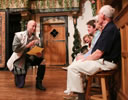 Love's Labour's Lost, American Shakespeare Center, Staunton, Virginia, September 22. In the hands of the ASC's actors skilled in verse-speaking and steeped in Shakespeare's production conditions, and helmed by Matthew Radford Davies with great comic vision, this production revealed this flowery poetic, wit-laden play to be a mirror held up to snobs of all sorts: noble, pedantic, romantic, and even peasant. Amid the many laughs, though, René Thornton Jr. delivered a virtuosic performance as Berowne, his "have at you then, affection's men at arms speech" an aria of superior artistic skill melded to a supreme work of art.
Love's Labour's Lost, American Shakespeare Center, Staunton, Virginia, September 22. In the hands of the ASC's actors skilled in verse-speaking and steeped in Shakespeare's production conditions, and helmed by Matthew Radford Davies with great comic vision, this production revealed this flowery poetic, wit-laden play to be a mirror held up to snobs of all sorts: noble, pedantic, romantic, and even peasant. Amid the many laughs, though, René Thornton Jr. delivered a virtuosic performance as Berowne, his "have at you then, affection's men at arms speech" an aria of superior artistic skill melded to a supreme work of art.
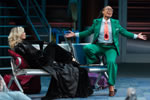 Twelfth Night, Shakespeare Theatre Company, Washington, D.C., November 20.The plane crash that started this production was a mighty impressive piece of stage business; but then, the Ethan McSweeny–directed company got down to the funny business of energetically and honestly presenting Shakespeare's comic masterpiece, leaving that opening an afterthought—until the ending revisited it. Memorable highlights, other than the luggage falling from the skies, were the multitalented Heath Saunders as Feste ("Come Away Death" is as moving as any piece of music I've heard in a Shakespeare production) and Jim Lichtscheidl presenting Aguecheek as a sporting fool.
Twelfth Night, Shakespeare Theatre Company, Washington, D.C., November 20.The plane crash that started this production was a mighty impressive piece of stage business; but then, the Ethan McSweeny–directed company got down to the funny business of energetically and honestly presenting Shakespeare's comic masterpiece, leaving that opening an afterthought—until the ending revisited it. Memorable highlights, other than the luggage falling from the skies, were the multitalented Heath Saunders as Feste ("Come Away Death" is as moving as any piece of music I've heard in a Shakespeare production) and Jim Lichtscheidl presenting Aguecheek as a sporting fool.
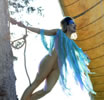 The Tempest, Shakespeare & Company, Lenox, Massachusetts, September 1. Magic inevitably happens in outdoor theaters, as with this production inaugurating Shakespeare & Company's Roman Garden Theatre. You hear wind blowing when Ariel enters, and feel the breeze, too. You see the huge pine in which she was imprisoned until Prospero freed her. Allyn Burrows's direction ingeniously employed the play space, but it's the acting that fascinates most. Nigel Gore played a particularly vexed (lonely?) Prospero with Ella Loudon as his rebellious daughter. The two snarled at each other one minute and the next embraced like their lives depended on their love.
The Tempest, Shakespeare & Company, Lenox, Massachusetts, September 1. Magic inevitably happens in outdoor theaters, as with this production inaugurating Shakespeare & Company's Roman Garden Theatre. You hear wind blowing when Ariel enters, and feel the breeze, too. You see the huge pine in which she was imprisoned until Prospero freed her. Allyn Burrows's direction ingeniously employed the play space, but it's the acting that fascinates most. Nigel Gore played a particularly vexed (lonely?) Prospero with Ella Loudon as his rebellious daughter. The two snarled at each other one minute and the next embraced like their lives depended on their love.
 Coriolanus, American Shakespeare Center, Blackfriars Playhouse, Staunton, Virginia, January 21. A quiet moment created one of this year's most indelible images: Allison Glenzer sitting with René Thornton Jr. on the Blackfriars stage conversing in simple intimacy. He was Coriolanus, she Volumnia, and the scene exemplified an original production practices staging (in steampunk costumes) of this richly textured ensemble piece in which the cast created a matrix of personalities that pieced together the Caius Martius Coriolanus as played by Thornton. His was not an antihero portrayal but an endearingly—and disconcertingly—engaging guy while Glenzer offered a fittingly restrained portrayal of Volumnia in one of the most fulfilling productions of this play I've seen.
Coriolanus, American Shakespeare Center, Blackfriars Playhouse, Staunton, Virginia, January 21. A quiet moment created one of this year's most indelible images: Allison Glenzer sitting with René Thornton Jr. on the Blackfriars stage conversing in simple intimacy. He was Coriolanus, she Volumnia, and the scene exemplified an original production practices staging (in steampunk costumes) of this richly textured ensemble piece in which the cast created a matrix of personalities that pieced together the Caius Martius Coriolanus as played by Thornton. His was not an antihero portrayal but an endearingly—and disconcertingly—engaging guy while Glenzer offered a fittingly restrained portrayal of Volumnia in one of the most fulfilling productions of this play I've seen.
 Measure for Measure, The Night Shift, New York, New York, March 23. By one important measure, this was my number one production of the year: It was my son's New York directorial debut. But as the Shakespeareances.com guy, I'm ranking this on its merits. Under Jonathan Minton's direction, this was a profoundly relevant Measure for Measure as it tracked the imbedded sexism of a Vienna society governed by the most Machiavellian Duke ever in Colin B. Gold's performance. Minton assembled a strong ensemble with special kudos to Mariette Strauss who portrayed Juliet with a sense of self-empowerment and a hilarious but touching Pompey through an appropriately rendered regendering.
Measure for Measure, The Night Shift, New York, New York, March 23. By one important measure, this was my number one production of the year: It was my son's New York directorial debut. But as the Shakespeareances.com guy, I'm ranking this on its merits. Under Jonathan Minton's direction, this was a profoundly relevant Measure for Measure as it tracked the imbedded sexism of a Vienna society governed by the most Machiavellian Duke ever in Colin B. Gold's performance. Minton assembled a strong ensemble with special kudos to Mariette Strauss who portrayed Juliet with a sense of self-empowerment and a hilarious but touching Pompey through an appropriately rendered regendering.
 Queen Lear, Children's Shakespeare Theatre, Palisades, New York, March 24. Textual choices undermined the thematic potential of regendering Lear to explore mother-daughter relationships. Yet we were wowed by some of the performances, such as Amalia Baker's showmanship and empathy as the Fool, Elinor Greenway's vicious, eyeball-stomping gusto as Regan, Nina Carbone's multiple personality portrayal of Edgar, and Isabel Wecht's seething coil of violence as Edmund. And that Edmund-Edgar fight was breathtaking (and a most apt culmination of their thematic journeys through the play). These weren't just talented kids, they're true Shakespeareans.
Queen Lear, Children's Shakespeare Theatre, Palisades, New York, March 24. Textual choices undermined the thematic potential of regendering Lear to explore mother-daughter relationships. Yet we were wowed by some of the performances, such as Amalia Baker's showmanship and empathy as the Fool, Elinor Greenway's vicious, eyeball-stomping gusto as Regan, Nina Carbone's multiple personality portrayal of Edgar, and Isabel Wecht's seething coil of violence as Edmund. And that Edmund-Edgar fight was breathtaking (and a most apt culmination of their thematic journeys through the play). These weren't just talented kids, they're true Shakespeareans.
- Taming of the Shrew, American Shakespeare Center, Staunton, Virginia, December 29 (not yet reviewed). In this slapstick-rich rendering, Director Jemma Alix Levy stays true to Shakespeare's text and finds true romance in the characters' behaviors. She also sees a stout feminist in Katherina, inventively played by Annabelle Rollison. Everybody is playing the game in Paduan society except Kate, so Petruchio, in Ronald Román-Meléndez's endearing performance, doesn't so much "tame" Kate as teach her how to play the game while sharing in her hardships. Both win out, as does the audience with this strong ensemble piece.
-sm.jpg) Measure for Measure, Theatre for a New Audience, Brooklyn, New York, June 29. It started with foreplay: We entered the theater through the backstage made over as Mistress Overdone's brothel. The mystery rooms, phallic toys, S&M weaponry, and a stoned customer set the psychological stage for the stage play to come, in which director Simon Godwin unleashed Shakespeare's characters onto an ever-shifting socio-political landscape where each must come to a moral reckoning. Yet, Godwin maintained Shakespeare's comic intentions, happy ending and all. At the core was Cara Ricketts's Isabella as an effervescent novice, whose interactions with the politically shrewd Angelo (Thomas Jay Ryan) and Claudio, her brother Claudio (Leland Fowler)—the customer in the brothel—were riveting.
Measure for Measure, Theatre for a New Audience, Brooklyn, New York, June 29. It started with foreplay: We entered the theater through the backstage made over as Mistress Overdone's brothel. The mystery rooms, phallic toys, S&M weaponry, and a stoned customer set the psychological stage for the stage play to come, in which director Simon Godwin unleashed Shakespeare's characters onto an ever-shifting socio-political landscape where each must come to a moral reckoning. Yet, Godwin maintained Shakespeare's comic intentions, happy ending and all. At the core was Cara Ricketts's Isabella as an effervescent novice, whose interactions with the politically shrewd Angelo (Thomas Jay Ryan) and Claudio, her brother Claudio (Leland Fowler)—the customer in the brothel—were riveting.
 Julius Caesar, Chesapeake Shakespeare Company, Baltimore, Maryland, October 13. Michael Tolaydo's smart, modern-dress production turns Shakespeare's parable for his time into a parable for our time thanks to the performances of the key (and timeless) figures in this story: the egotistical but politically astute Caesar (Michael P. Sullivan), the even-more-egotistical and single-focused Brutus (Ron Heneghan), the intelligently volatile Cassius (Vince Eisenson), and the slyly manipulative Mar Antonia (Briana Manente). Re-gendering Antony and Octavius (as Octavia) matters less than the Millennial casting of Caitlin Carbone as Octavia and Eisenson as Cassius, heavyweight performances that thankfully overcome cringing portrayals of some lesser characters.
Julius Caesar, Chesapeake Shakespeare Company, Baltimore, Maryland, October 13. Michael Tolaydo's smart, modern-dress production turns Shakespeare's parable for his time into a parable for our time thanks to the performances of the key (and timeless) figures in this story: the egotistical but politically astute Caesar (Michael P. Sullivan), the even-more-egotistical and single-focused Brutus (Ron Heneghan), the intelligently volatile Cassius (Vince Eisenson), and the slyly manipulative Mar Antonia (Briana Manente). Re-gendering Antony and Octavius (as Octavia) matters less than the Millennial casting of Caitlin Carbone as Octavia and Eisenson as Cassius, heavyweight performances that thankfully overcome cringing portrayals of some lesser characters.
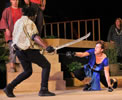 Romeo and Juliet, Elm Shakespeare Company, New Haven, Connecticut, August 31. Director Raphael Massie's textual tweaks serve his thematic purposes well as he uses the play to illustrate the consequences of engaging in and enabling violence. From keeping Mercutio on stage during his death to having the already-poisoned Romeo awaken Juliet with his kiss, such staging decisions resonate viscerally. And the fights by Fight Director Ted Hewlett and his assistant Claire Warden (who played Tybalt) are incredibly choreographed, wide-ranging, and skillfully fought—feeding Massie's thematic purposes as our enjoyment in the brawls made us complicit in the tragic consequences of violence.
Romeo and Juliet, Elm Shakespeare Company, New Haven, Connecticut, August 31. Director Raphael Massie's textual tweaks serve his thematic purposes well as he uses the play to illustrate the consequences of engaging in and enabling violence. From keeping Mercutio on stage during his death to having the already-poisoned Romeo awaken Juliet with his kiss, such staging decisions resonate viscerally. And the fights by Fight Director Ted Hewlett and his assistant Claire Warden (who played Tybalt) are incredibly choreographed, wide-ranging, and skillfully fought—feeding Massie's thematic purposes as our enjoyment in the brawls made us complicit in the tragic consequences of violence.
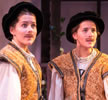 Twelfth Night, Titan Theatre Company, Queens, New York, March 25. Though identical twins played the twin Viola and Sebastian, director Lenny Banovez didn't take any theatrical advantage of this casting. So why do it? Because half of the casting was superb, with Sierra Tothero presenting a sublime Viola as she put Shakespeare's masterful poetry on perfect display (sister Lauren was a serviceable Sebastian). Sierra along with Tyler Moss as an ultraromantic Orsino and Lloyd Mulvey giving a keen portrayal of Malvolio lifted this production above the way-too-broad presentations of other roles and the lost opportunities of twins playing twins.
Twelfth Night, Titan Theatre Company, Queens, New York, March 25. Though identical twins played the twin Viola and Sebastian, director Lenny Banovez didn't take any theatrical advantage of this casting. So why do it? Because half of the casting was superb, with Sierra Tothero presenting a sublime Viola as she put Shakespeare's masterful poetry on perfect display (sister Lauren was a serviceable Sebastian). Sierra along with Tyler Moss as an ultraromantic Orsino and Lloyd Mulvey giving a keen portrayal of Malvolio lifted this production above the way-too-broad presentations of other roles and the lost opportunities of twins playing twins.
 King Lear, WSC Avant Bard, Arlington, Virginia, June 19. Like life, the impact of this production, staged simply in an intimate in-the-round theater, sneaked up and enveloped us. Rick Foucheux, in his last role before officially retiring from the stage, constrained his portrayal of Lear, making him accessibly human, and both Goneril (Alyssa Sanders) and Regan (Charlene V. Smith) built their resistance to Lear on practical matters that just happened to escalate into cruelty. A Cordelia with real spunk (Kathryn Zoerb), a keenly aware Kent (Vince Eisenson), and a well rounded Oswald (Louis E. Davis) outweighed missteps in presenting the Gloucester household.
King Lear, WSC Avant Bard, Arlington, Virginia, June 19. Like life, the impact of this production, staged simply in an intimate in-the-round theater, sneaked up and enveloped us. Rick Foucheux, in his last role before officially retiring from the stage, constrained his portrayal of Lear, making him accessibly human, and both Goneril (Alyssa Sanders) and Regan (Charlene V. Smith) built their resistance to Lear on practical matters that just happened to escalate into cruelty. A Cordelia with real spunk (Kathryn Zoerb), a keenly aware Kent (Vince Eisenson), and a well rounded Oswald (Louis E. Davis) outweighed missteps in presenting the Gloucester household.
 The Taming of the Shrew, Michigan Shakespeare Festival, Jackson, Michigan, July 15. Director John Neville-Andrews shifts Katherina's final speech to a lesson on partnership as opposed to right supremacy, and some other textual changes work well, too, especially ramping up the character of Hortensio (Robert Kauzlaric). Meanwhile, the primary highlights are less Shakespearean and more clever theatrical gags, such as Grumio (Shawn Pfautsch) kicking a bucket on mention of Petruchio's father and modeling the tailor's dress, Biondello (Eric Eilersen) carrying a stack of books of which the smallest is the heaviest, and Ian Geers turning Lucentio into a genuinely funny fellow.
The Taming of the Shrew, Michigan Shakespeare Festival, Jackson, Michigan, July 15. Director John Neville-Andrews shifts Katherina's final speech to a lesson on partnership as opposed to right supremacy, and some other textual changes work well, too, especially ramping up the character of Hortensio (Robert Kauzlaric). Meanwhile, the primary highlights are less Shakespearean and more clever theatrical gags, such as Grumio (Shawn Pfautsch) kicking a bucket on mention of Petruchio's father and modeling the tailor's dress, Biondello (Eric Eilersen) carrying a stack of books of which the smallest is the heaviest, and Ian Geers turning Lucentio into a genuinely funny fellow.
- A Midsummer Night's Dream, Shakespeare Opera Theatre, Aldie, Virginia, August 27. Combining Felix Mendelssohn's A Midsummer Night's Dream Incidental Music into a full production of the play is more than an enhancement of Shakespeare's work. It's a magical element all its own. This Lori Lind–directed production featuring a 10-piece live orchestra has both a community theater and opera aesthetic, the latter a positive quality (especially in Gregory Stuart as Oberon), the former overcome with the charm of having children play the myriad of fairies and Michael Harris giving a brilliantly nuanced portrayal of Bottom.
Honorable Mentions:
Top 5 Non-Shakespearean Theatrical Moments of 2017
 A King and No King and 'Tis Pity She's a Whore, Brave Spirits, Alexandria, Virginia, April 1 and March 31, respectively. Not a tie, but a repertory—the "Incest Rep." Brave Spirits packaged these two Jacobean plays centered on sibling sexual relationships using a single cast. The plays view the topic from different angles and styles of composition, and the two directors, Cassie Ash for A King and No King and Charlene V. Smith for 'Tis Pity She's a Whore, take appropriately different approaches to their texts. Whereas 'Tis Pity played like a hyperdramatic soap opera on Starz, King was a zinging ensemble comedy along the lines of Arrested Development. My favorite of the two is A King and No King, such a thoroughly modern piece in its character-driven ironic humor played with impeccable timing. While, I'm not a Ford fan, in the hands of this company his plot's sick twists slackened jaws in a way I've never seen before in a theater. The juxtaposition of the two, along with the talents of their shared casts, heightened the appreciation of both. Creating gut-wrenching shock and gut-busting laughter with a single cast in back-to-back performances was a crowning theatrical achievement for this small, fledgling company.
A King and No King and 'Tis Pity She's a Whore, Brave Spirits, Alexandria, Virginia, April 1 and March 31, respectively. Not a tie, but a repertory—the "Incest Rep." Brave Spirits packaged these two Jacobean plays centered on sibling sexual relationships using a single cast. The plays view the topic from different angles and styles of composition, and the two directors, Cassie Ash for A King and No King and Charlene V. Smith for 'Tis Pity She's a Whore, take appropriately different approaches to their texts. Whereas 'Tis Pity played like a hyperdramatic soap opera on Starz, King was a zinging ensemble comedy along the lines of Arrested Development. My favorite of the two is A King and No King, such a thoroughly modern piece in its character-driven ironic humor played with impeccable timing. While, I'm not a Ford fan, in the hands of this company his plot's sick twists slackened jaws in a way I've never seen before in a theater. The juxtaposition of the two, along with the talents of their shared casts, heightened the appreciation of both. Creating gut-wrenching shock and gut-busting laughter with a single cast in back-to-back performances was a crowning theatrical achievement for this small, fledgling company.
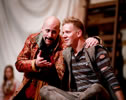 Peter and the Starcatcher, American Shakespeare Center, Staunton, Virginia, September 23. Theater magic at its best through great craftsmanship: A hilariously clever script (Rick Elice), intellectually accomplished direction (Jim Warren), and a talented cast (led by Benjamin Reed as Peter and Greg Brostrom as an omigod great Black Stache), in a theater (the Blackfriars Playhouse) with a tradition (Shakespearian) that invites the audience to share in the creative process through their own imaginations—though those dancing mermaids were beyond imagination. Time is the only true treasure, Black Stache says. The time spent watching this show and thinking about it ever since has given me great wealth indeed.
Peter and the Starcatcher, American Shakespeare Center, Staunton, Virginia, September 23. Theater magic at its best through great craftsmanship: A hilariously clever script (Rick Elice), intellectually accomplished direction (Jim Warren), and a talented cast (led by Benjamin Reed as Peter and Greg Brostrom as an omigod great Black Stache), in a theater (the Blackfriars Playhouse) with a tradition (Shakespearian) that invites the audience to share in the creative process through their own imaginations—though those dancing mermaids were beyond imagination. Time is the only true treasure, Black Stache says. The time spent watching this show and thinking about it ever since has given me great wealth indeed.
 Watch on the Rhine, Arena Stage, Washington, D.C., March 2. Hellman's bait-and-switch political thriller is not only relevant to our times but to our ongoing cultural naiveté. Even as I gained renewed appreciation for the playwright, I was astonished by the performances of this cast under the sure-handed direction of Jackie Maxwell: dramatic flesh-and-bones intensity from Andrew Long and Lise Bruneau as Kurt and Sara Müller; fine comic acting from Marsha Mason as Fanny Farrelly; a poignant performance by Natalia Payne as Marthe De Brancovis; and the smoothly dangerous evil and high-cultured yet imperfect villainy of J. Anthony Crane as Teck.
Watch on the Rhine, Arena Stage, Washington, D.C., March 2. Hellman's bait-and-switch political thriller is not only relevant to our times but to our ongoing cultural naiveté. Even as I gained renewed appreciation for the playwright, I was astonished by the performances of this cast under the sure-handed direction of Jackie Maxwell: dramatic flesh-and-bones intensity from Andrew Long and Lise Bruneau as Kurt and Sara Müller; fine comic acting from Marsha Mason as Fanny Farrelly; a poignant performance by Natalia Payne as Marthe De Brancovis; and the smoothly dangerous evil and high-cultured yet imperfect villainy of J. Anthony Crane as Teck.
 The School for Lies, Shakespeare Theatre Company, Washington, D.C., June 5. A David Ives–penned, Michal Kahn–directed "translaptation" of a French classic, in this instance Molière's Le Misanthrope, is an automatic top five ranking, even if this Ives-Kahn collaboration ranks fourth compared to the three previous efforts. In addition to Ives' brilliantly silly rhyming couplets and Kahn's act-it-with-utmost-dignity standard, kudos go to a bizarrely kitschy set by Alexander Dodge, historically fantastical costumes by Murell Horton, the disarmingly charming Gregory Wooddell as Frank (the misanthrope), and the subtly perfect Cody Nickell as Frank's friend Philinte.
The School for Lies, Shakespeare Theatre Company, Washington, D.C., June 5. A David Ives–penned, Michal Kahn–directed "translaptation" of a French classic, in this instance Molière's Le Misanthrope, is an automatic top five ranking, even if this Ives-Kahn collaboration ranks fourth compared to the three previous efforts. In addition to Ives' brilliantly silly rhyming couplets and Kahn's act-it-with-utmost-dignity standard, kudos go to a bizarrely kitschy set by Alexander Dodge, historically fantastical costumes by Murell Horton, the disarmingly charming Gregory Wooddell as Frank (the misanthrope), and the subtly perfect Cody Nickell as Frank's friend Philinte.
- The Front Page, Broadhurst Theatre, New York, New York, January 28. This play written by Ben Hecht and Charles MacArthur in 1928 is timelessly hilarious, portraying the personalities and career conditions of journalists along with their professional idiosyncrasies. As such, watching this all-star-cast Broadway production gave me flashbacks through points in my career, including the bellicose editor Walter Burns. Nathan Lane as Burns not only nailed a character I know so well from experience, he also worked with tremendous generosity toward his castmates. While the play is about my profession, my greatest takeaway was watching an actor mastering his profession.
The rest of the Shakespeareances …
- Antony and Cleopatra, Orlando Shakespeare Theater, Orlando, Florida, April 27. This ranking is the medium between Antony and Cleopatra. While Michael Dorn's Antony was more Vulcan than Klingon in his dispassionate playing of the role, Caralyn Kozlowski's Cleopatra was a vacation in and of herself, visually and sensually, in a beguiling performance that was subtly over the top in the beginning but true to the play's romantic heart at the end. When Cleopatra in her description of Antony out-shines a fine Enobarbus (Jeorge Bennett Watson) in his description of her, that's a star turn in Joseph Disher's otherwise steady-though-streamlined production.
- Macbeth, Cleveland Shakespeare Festival, Cleveland, Ohio, July 22. Aside from one of the keenest portrayals of Banquo I've ever seen (Allen Branstein), what stands out in this production is Director Tyson Douglas Rand using touring production conditions as effective allegorical properties (including doubling Robert Hawkes as Duncan and the Porter and having him appear as the king's ghost with Banquo's ghost). Then there were the poignant sound effects courtesy of the locale: in downtown Cleveland's noisy Public Square, including the Old Stone Church's bell tolling on the quarter hour and on cue as ominous warnings for Macbeth.
- Henry VI, Part 3, American Shakespeare Center, Staunton, Virginia, September 21. After this company's superb presentation of Part 2 last year, this outing suffers a come-down, due in part to a lapse of focus in directing (which changed hands during rehearsals). It thrives most on chaotic energy, which was fun, but its greatest assets were some fine performances, especially from Allison Glenzer as Margaret, René Thornton Jr. as Richard, Josh Innerst as an unrelentingly two-dimensional Warwick, and David Anthony Lewis as "the father who kills his son," whose heart-rending five minutes on stage is what this play is all about.
- Macbeth, American Shakespeare Center, Staunton, Virginia, December 30 (not yet reviewed). Concentrating on Macbeth's love plot—albeit, a romance disintegrating—Director (and ASC veteran actor) Benjamin Curns slows the play's pace to emphasize the relationships of characters to each other and to their own psyches. Nevertheless, the production maintains the play's suspense, and the action sequences are electric. Then there's the witches. Not only do Hilary Alexa Caldwell, Kyle Powell, and Annabelle Rollison make for a disturbingly evil trio of weird sisters, a ram-horned, winged Mitchell McCollum gets his due in the play's plot and the production's occult aesthete.
- King John, 4615 Theater Company, Bethesda, Maryland, August 6. Pairing this production in repertory with James Goldman's The Lion in Winter doesn't necessarily improve either play, but it does highlight the talents of Seth Rosenke, the actor playing the title role in this production. Through his physical mannerisms, facial expressions, and a fluid command of Shakespeare's verse, Rosenke presents a complexly compelling King John despite making him little more than a snot. Director Jordan Friend smartly switches to a modern dress setting, but his interpolated scenes of ghosts and conspiracies intrude on Rosenke's and other fine performances (such as Jacqueline Chenault's Constance).
- As You Like It, Folger Theatre, Washington, D.C., January 29. This Gaye Taylor Upchurch–helmed production, produced in association with Hudson Valley Shakespeare Festival, was heading for the rocks by the time we got to intermission, thanks to stodgy theatricality and restrained acting. But in the second half, great comic performances came to the fore, including Dani Stoller's, lifting Phoebe to the realm of great comic character of the canon. Though the musical interludes were overlong and not especially good, the production reached a happy ending, Hyman and all.
- Julius Caesar, Michigan Shakespeare Festival, Jackson, Michigan, July 15. Envisioning a Roman Republic lasting into the 21st century, Director Janice L. Blixt gives this production a clever visual context and one of the most powerful assassinations of Caesar I've ever seen. But her textual cuts (the entire first scene, Antony's ambassador) and streamlining (all the conspirators make it to Philippi except one) gut Shakespeare's play of its psychological essence and dramatic verve.
- Macbeth, Shakespeare Theatre Company, Washington, D.C., May 1. This production planted a mirror in our consciences as the sovereignty-meddling Western capitalist interests in Africa—via Hecate and the witches—become sovereignty-meddling Eastern capitalist interests in our own nation. But this Hecate isn't Shakespeare's, and this Macbeth isn't either as Jesse J. Perez gives him a Borscht Belt comic timbre. There's some fine Shakespearean performances (Nikkole Salter as Lady Macbeth, McKinley Belcher III as Banquo), and the modernization of elements grafted to the text are comprehensively clever, but I can't get past the audience laughing during Duncan's murder and the Dunsinane scenes.
- Much Ado About Nothing, NextStop Theatre Company, Herndon, Virginia, January 22. One scene, the aborted wedding climaxing with Benedick (Jonathan Lee Taylor) and Beatrice (Kari Ginsburg) expressing their love for each other, could land this entry atop this list as Director Abigail Isaac Fine and her two accomplished actors surface the psychological elements of the couple's relationship in a truly tear-jerking moment. But other choices by Fine, especially turning Dogberry (Robert Pike, who showed great comic astuteness as Don John) into a buffoonish sexual predator and his scenes into over-the-top physical farces, send the production into a path of quicksand.
- Much Ado About Nothing, Hoosier Shakes, Marion, Indiana, July 22. This might seem a copy-and-paste of the entry immediately above as this production turned Dogberry (Austin Hendricks, who showed great textual insight as a deliciously dangerous Don John) into a hyperventilating crazy man. What sets this production a notch below is that such over-the-top physical humor also undermined the portrayals of Benedick and Leonato. Where this show scored was in its heartfelt boy-to-man reading of Claudio (Deon Releford-Lee) and Leonato reading the letter that starts the play as an all-cast, song-and-dance performance of Thin Lizzy's "The Boys Are Back in Town."
- Antony and Cleopatra, Folger Theatre, Washington, D.C., November 2. Nigel Gore, playing Enobarbus here, can do no wrong—though this production put him to the test. And Simoné Elizabeth Bart keenly turned Charmian into an efficient and effective chief of staff figure in Cleopatra's court. Otherwise, this Robert Richmond–helmed production, with its mixed visual metaphors, misunderstanding of textual themes and Shakespeare's purpose, and a misguided reconfiguration of the Folger into a theater-in-the-round, was listless, sometimes senseless, and certainly sexist the way it downgraded the political skills and deep intelligence of Cleopatra.
- Richard III, Chesapeake Shakespeare Company, Baltimore, Maryland, March 4. This had all the ingredients it needed to succeed: namely, Vince Eisenson as Richard, and in a World War I setting, to boot. The setting, however, didn't contribute to the production's themes—if there were any themes—and while Eisenson showed flashes of brilliance, his Richard had too difficult a course to slalom through in a production suffering from textual cuts, poorly interpreted characters, and lack of thematic coherence.
- Timon of Athens, Folger Theatre, Washington, D.C., June 1. Another Shakespeare play channeled through the intrusive imagination of director Robert Richmond, who sees Timon as a person with mental health issues who falls into insanity in the second half, totally contrary to the text's intents. Ian Merrill Peakes was fine in the title role, but how much better he would have been as the real Timon of Shakespeare's play. Meanwhile, the usually reliable Eric Hissom played Apemantus as, apparently, a Timon delusion, wasting the actor's talents with a hollow, two-dimensional portrayal of the play's most fascinating character.
…and the rest of the non-Shakespeareances:
- The Select (The Sun Also Rises), Elevator Repair Service, Shakespeare Theatre Company, Washington, D.C., February 27. Elevator Repair Service turns the actual experience of reading a novel (Hemingway's first) into theatrical art beyond a simple stage reading. Using the actual text (albeit, trimmed) of the novel and layering it with metatheater devices, immersive sound effects, and strong acting performances, the company creates a show in which we are as empowered in the staging, via our imagination, as the ensemble. It was great theater and, in the end, a great read, too.
- School for Scandal, American Shakespeare Center, Staunton, Virginia, April 9. Circumstances made this a great theatrical event. Richard Brinsley Sheridan's script certainly is witty and the ASC actors certainly are talented. However, the fact that this was staged in Blackfriars Playhouse conditions during the Actors' Renaissance Season exponentially raised the play's theatrical quotient. Throw in two boys on the gallants' stools portraying a "two-headed uncle" in a family portrait, and we get one of those great, only-at-the-Blackfriars theatrical moments that take up permanent residence in our memories.
- The Lion in Winter, 4615 Theater Company, Bethesda, Maryland, August 6. Jordan Friend helmed this play along with its repertory pair, William Shakespeare's King John, and his visionary talents were better applied here. Clever costuming, poignant lighting, and scene changes that not only were functional but gave us more depth to the play's characters and added dramatic heft to James Goldman's medieval royal soap opera. Nick Torres played a subtly understated Henry, and Charlie Cook's Geoffrey was wonderfully too clever for his own good, while Seth Rosenke firmly established his compelling two-play journey as Prince-cum-King John.
- Sense and Sensibility, American Shakespeare Center, Staunton, Virginia, December 30 (not yet reviewed). Emma Whipday's adaptation of Jane Austen's novel plods along verbally in some spots while Stephanie Holladay Earl's direction counters with much stage business. Nevertheless, this is still Austen, capable of achieving goose-pimple romanticism in all the right places, and this ensemble dives into the very humanity of each character highlighted by sisters Elinor Dashwood (Ally Farzetta) and Marianne (Constance Swain) and a show-stopping portrayal of the gossip Mrs. Jennings by Topher Embrey.
- King Charles III, Shakespeare Theatre Company, Washington, D.C., February 12. Mike Bartlett presents an engaging political drama with familiar characters by looking ahead to Charles ascending the English throne and instigating a political crisis. Thus does Bartlett, writing in iambic pentameter blank verse, give us a Shakespeare history play for our times. It's an audacious effort, more interesting in how it identifies with Shakespeare's Richard and Henry plays than satisfying in its employment of verse for dialogue. But a highlight is Kate (Allison Jean White), who uses the media image we know so well to achieve a power greater than divine right or politics.
- Dr. Faustus, Brave Spirits Theatre, Alexandria, Virginia, October 27. Christopher Marlowe's pedantic pacing and comic non-sensibilities are obstacles for any company to overcome. However, Director Paul Reisman and Charlene V. Smith, who plays Dr. Joan Faustus, manage to stage a story with searing relevancy by re-gendering the title character and making her a Millennial. Her urgent need to count and an attitude that 24 years is, like, forever contribute to her making a deal of damnation with the devil. In the end, though, we discover that Joan Faustus, stuck in a male-entrenched system, was damned even before she meets Lucifer.
- The Lover / The Collection, Shakespeare Theatre Company, Washington, D.C., October 2. Perhaps it's not fair for me to rank a pair of productions by a playwright, Harold Pinter, I don't fully appreciate and with whom I'm inadequately familiar. But this is about my experience with the plays and productions, and as I came out of the theater shaking my head over the The Lover and nodding in recollection of The Collection, that counts as a high score in my visceral and intellectual reaction to this twin bill.
- Shakespeare's Sister, American Shakespeare Center, Staunton, Virginia, April 7. Premiering during the Actors' Renaissance Season at the Blackfriars Playhouse, Emma Whipday's new play about women's place in Shakespeare's theater throbs with potential. Alas, it ironically fails to fit into the Shakespeare-replica play space, and the script plays more like a National Park Service history dramatization than live theater. Ah, but the ASC players, with especially fine performances from Benjamin Reed as Richard Burbage and Allison Glenzer as Joan Henslow, simply don't allow the play to succumb to its own detriments.
- The Trojan Women, Taffety Punk, Washington, D.C., March 1. A new generation of Riot Grrrls departs from the company's traditional Shakespearean offer to do Euripides' prescient play about disenfranchised women. It's not just the women's voices as victims of war but also their refugee status that made this such a pertinent staging by Kelsey Mesa. D.C. theater veteran Brigid Cleary as Hecuba anchored a generally strong ensemble, with Shanara Gabrielle turning in two fine performances as an achingly moving Andromache and a rivetingly pissed Poseidon.
- Goodnight Desdemona (Good Morning Juliet), American Shakespeare Center, Staunton, Virginia, May 6 (not reviewed). Ann-Marie MacDonald's play about a mousey university professor, Constance, magically transported into Shakespeare's Othello and Romeo and Juliet, where she alters the plots, never quite gels despite its potential (such as Constance announcing Romeo's marriage to Juliet just ahead of Tybalt's fateful duel with Mercutio, turning everybody into blood brother buddies). Golden performances by a talented ASC touring troupe were passing pleasing, but the whole suffers from the play's reliance on insider winks at academia for much of its humor and a plot that comes unglued at its climax.
Comment: e-mail editorial@shakespeareances.com
Start a discussion in the Bardroom



 Find additional Shakespeareances
Find additional Shakespeareances